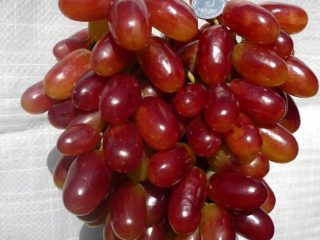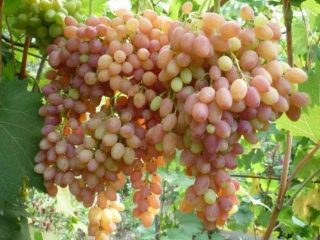Content
Despite the almost annual appearance of new promising hybrid forms of grapes, old time-tested varieties are in no hurry to disappear from vineyards, and simply from the summer cottages of gardeners throughout Russia. Nadezhda Azos grapes, which at one time became one of the most promising new products in the art of viticulture, still do not lose their leadership positions. It continues to remain firmly in the top ten most popular grape varieties throughout Russia.
And even despite the borderline ripening periods for berries for the so-called northern viticulture regions, its spread in regions far from traditional grape cultivation is truly surprising. Apparently, this is due to the very late awakening of buds and flowering of grape bushes, which allows in relatively northern regions to avoid damage to grapes by recurrent spring frosts. The description of the grape variety Nadezhda Azos and the accompanying photographs will help you decide whether it is worth starting this variety on your site. But, according to reviews from those who have been growing these grapes for many years, every year they only become more stable and beautiful.
History of creation
In the 70s of the twentieth century, scientific breeders of the Anapa Zonal Station of Horticulture and Viticulture developed a new hybrid form of table grapes, which subsequently received the name Nadezhda AZOS at its place of origin.
The variety arose as a result of a hybrid crossing of two famous and beloved grape varieties: Moldova and Cardinal. Cardinal had to leave the vineyards by now due to very weak resistance to various fungal diseases, but he was able to transfer some of his amazing taste to his brainchild and shifted the ripening dates to earlier. Because Moldova, for all its positive qualities - huge productivity, resistance to diseases and stability of fruiting - has very late ripening periods, unacceptable for most regions of Russia, except for the southernmost ones.
After many years of testing, only in 1991 the Nadezhda AZOS grapes were submitted as a candidate for registration in the State Register of Russia. But times were difficult and difficult, so it was only in 1998 that these grapes finally deservedly received the full right to be called a variety and were included in the State Register with limited access to cultivation in the North Caucasus region.
However, lovers of this variety, of course, were not stopped by territorial restrictions in cultivation, and Nadezhda AZOS grapes began to spread further north every year until they reached the Moscow region and Belarus, where they successfully ripen for many years and only need in additional shelters with non-woven materials.
Description of the variety
The Nadezhda Azos grape bushes obviously belong to the vigorous group and have such powerful growth energy that they require mandatory annual formation and pruning. The dark green leaves are very large in size, have three or five lobes and dense cobwebby pubescence. The bunches are firmly attached to the shoots with thick stalks.
The flowers are bisexual, which means that Azos grapes do not need additional pollinators. True, this grape variety is not characterized by the best pollination of flowers in rainy weather. In this regard, the opinions of winegrowers differ: some complain about poor pollination and, as a consequence, cluster set, others admire the fact that Nadezhda Azos shows good set even during weeks of heavy rains. Apparently, a lot depends on the characteristics of caring for grape bushes - this variety, due to its high growth energy, has a tendency to thicken with shoots. All weak shoots must be removed either during autumn pruning or in spring, otherwise, due to excessive thickening, the ovaries may fall off.
The fruitfulness of the shoots is quite high - on average it is 80-90%. The ripening of shoots is good along their entire length.
From three to five clusters can form on the vine; the bush will strive to carry the entire formed harvest, and in order not to overstrain its strength, it is necessary to leave no more than one or two clusters on each shoot.
The rooting ability of cuttings of this variety is rather weak and unstable. For example, roots may form, but the eyes will not wake up. On average, judging by reviews from gardeners, only 50-70% of Nadezhda Azos grape cuttings turn into full-fledged healthy bushes.
Nadezhda Azos grape bushes produce fruit quite quickly. The first small, so-called signal clusters, are usually removed the next year after the seedlings are planted. Every year, the yield itself, the size of the clusters, and the stability of fruiting only increase. In general, the yield indicators of this variety are at a very high level; from one adult bush you can easily get up to 30 kg of grapes.
Based on the ripening period, the originators classify Nadezhda Azos grapes as early varieties, but based on the experience of growing them in most regions, they should rather be classified as mid-early varieties. It takes about 120-130 days from the swelling of the buds to the ripening of the berries. It should also be borne in mind that the bud break and flowering of Nadezhda Azos is very late. In terms of flowering time, this variety is one of the latest, which is a great advantage for all regions with unstable weather conditions during spring. But subsequently, the grape shoots grow and develop so quickly that they catch up and even overtake some of their comrades. The ripening of the bunches begins from the second half of August (in the south) until the end of September (in the middle zone), where these grapes are one of the last to ripen.
The berries are well preserved on the bushes and are damaged by wasps to a lesser extent than other varieties. Apparently, this is due to the relatively dense skin of the berries.
The frost resistance of the bushes is average - the buds can withstand frosts down to -22°C without shelter. In most Russian regions, this variety requires mandatory shelter for the winter.
Nadezhda Azos shows good resistance to most fungal diseases. To mildew and oidium - good resistance, about 4 points. For gray rot – average, about three points.
Characteristics of bunches and berries
Among black-fruited grape varieties, Nadezhda Azos is distinguished by stable and high yield and good harmonious taste.
The video below well illustrates all the main characteristics of Nadezhda Azos grapes.
The variety has the following characteristics:
- The clusters are predominantly conical in shape, with various shoots and “tongues”. You can’t call them particularly dense; on the contrary, they are rather loose.
- The older the grape bush becomes, the larger the clusters on it can ripen under favorable conditions. On average, the weight of one brush is 500-700 grams. But record brushes weighing from 1.7 to 2.3 kg are known.
- The berries have a fairly standard oval shape, large in size, about 24 by 28 mm, weighing from 6 to 9 grams.
- The flesh is dense, fleshy and crispy. The skin is quite dense, but quite edible.
- The grapes are so dark blue that they appear almost black and are covered with a slight waxy coating.
- The seeds are not found in all berries; they are medium in size and not very noticeable when eaten.
- The taste of the berries of this variety is dessert, sweet, with a slight sourness, simple but harmonious.Tasters rate it 8.2 points out of 10.
- If the berries are not fully ripe, you can note their slight astringency.
- Sugar reaches 14-15%, acidity is about 10.2%.
- The berries are kept very well; on average, they can be stored in the refrigerator for about a month. But, according to some gardeners, they manage to preserve Nadezhda Azos grapes until the New Year.
- Naturally, the berries are also distinguished by excellent transportability.
- Grapes of this variety are considered table grapes. Indeed, it is quite rarely used for winemaking. But it makes wonderful juices, compotes, pastilles and other preparations.
As for the stability of the berries themselves, it is at an average level. On the one hand, peas are observed much less frequently than in other varieties, for example, Kodryanka. On the other hand, it directly depends on the load on the grape bushes with inflorescences, and the overall load on the shoots. Try not to overload the bushes of Nadezhda Azos and she will thank you with a high-quality and timely harvest.
Reviews from gardeners
Gardeners have long appreciated and loved the Nadezhda Azos grape variety and even affectionately call it Nadyushka. The vast majority of those who grow it do not intend to part with it in the coming years.
Conclusion
The Nadezhda Azos grape is a variety that shows stability and reliability in almost all weather conditions. He only needs to normalize the inflorescences, especially in the first years of life. Otherwise, it will delight you with a good harvest and a dessert taste of berries with easy care.















